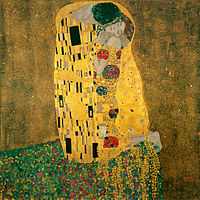Gustav Klimt
From Wikipedia, the free encyclopedia.

Gustav Klimt (July 14, 1862 – February 6, 1918) was an Austrian Symbolist painter and one of the most prominent members of Vienna Art Nouveau (Vienna Secession) movement.
Contents |
Life and art
Gustav Klimt was born in Baumgarten, near Vienna, Austria. He was educated at the Vienna Kunstgewerbe Art School in the years 1879-1883. Klimt was also an honorary member of the Universities of Munich and Vienna.

His major works include paintings, murals, sketches and other art objects, many of which are on display in the Vienna Secession gallery.
His work is distinguished by an elegant use of gold backgrounds and mosaic patterns. This can be seen in Judith I (1901), and in The Kiss (1907). Art historians note an eclectic range of influences contributing to Klimt's distinct style, including Egyptian, Minoan, Classical Greek, and Byzantine inspirations. Klimt was also inspired by engravings of Albrecht Dürer, late medieval European painting, and Japanese Ukiyo-e.
Klimt was one of the founding members of the Wiener Sezession (Vienna Secession) and of the periodical Ver Sacrum. He left the movement in 1908.
He died in Vienna of pneumonia and was interred at the Hietzing Cemetery, Vienna.
Legacy
Klimt's work had a clear influence on the paintings of Egon Schiele.
In November of 2003, Klimt's Landhaus am Attersee sold for $29,128,000.
Raoul Ruiz has directed a biopic, Klimt, starring John Malkovich in the title role which is expected to be released in late 2005.
Selected works
- University of Vienna Festsaal ceiling paintings
- Palais Stocklet mosaic in Brussels
- Judith I (1901)
- Buchenwald (Birkenwald) (1901)
- The Hydra (Wasserschlangen I) (1904)
- Judith II Also known as Salomé (1909)
- Fritsa Reidler (1906)
- Danaë (1907)
- Adele Bloch-Bauer I (1907)
- The Kiss (1907)
- Adele Bloch-Bauer II (1912)
- The Virgins (Die Jungfrau) (1913)
- Houses in Unterach on the Attersee (1916) [1]
- Beethoven frieze at the Secession Gallery in Vienna [2] [3]





